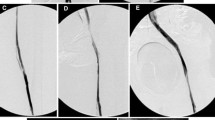Abstract
Purpose
To analyze the immediate outcome of percutaneous mechanical thromboembolectomy in acute infrainguinal leg ischemia in a consecutive cohort of patients with acute lower limb ischemia.
Material and Method
We retrospectively analyzed the data of 156 acute infrainguinal ischemic events in 148 patients. Patients presented with acute limb ischemia Rutherford category I in 68 cases (44%), Rutherford category II A in 64 instances (41%) and Rutherford II B in 24 instances (15%). In 62 cases (39.7%), the occlusion site started below the knee joint level, in 94 (60.3%) cases above. As a basic technique, an intervention was started by manual aspiration but if aspiration failed, an additional device was added. Most frequently, a rotational thrombectomy device (Rotarex, Straub Medical, Wangs, Switzerland) was used. An antegrade access to the femoral artery was the preferred access to the limb (154/156).
Results
In 145 of 156 incidents, a technical success was achieved (93%). Aspiration was used in 153 cases (98%). Rotational thrombectomy by use of the Rotarex catheter was added in 60 cases (38%). Directional atherectomy was applied in a total of five patients. As main technical complications, a downward embolization occurred (n = 11). There were four surgical groin revisions. Five patients died during the early follow-up with four not related to the intervention. Clinically, 135 patients (86.5%) showed an improvement in their clinical situation.
Conclusion
Acute lower limb ischemia can be successfully treated by mechanical thromboembolectomy only by combining aspiration embolectomy with rotational thrombectomy in most cases but manual aspiration alone will frequently fail especially above the knee joint level.



Similar content being viewed by others
References
Starck E, McDermott J, Crummy A, Turnipseed W, Acher C, Burgess J. Percutaneous aspiration thromboembolectomy. Radiology. 1985;156:51–6.
Sniderman K, Bodner L, Saddekni S, Srur M, Sos T. Percutaneous embolectomy by transcatheter aspiration. Work in progress. Radiology. 1984;150:357–61.
Rutherford R, Flanigan P, Gupta S, Johnson W, Karmody A, Whittemore A, Baker D, Ernst C, Jamieson C, Mehta S. Suggested standards for reports dealing with lower extremity ischemia. J Vasc Surg. 1986;4:80–94.
Dregelid E, Stangeland L, Eide G, Trippestad A. Patient survival and limb prognosis after arterial embolectomy. Eur J Vasc Surg. 1987;18:263–71.
Morrison H. Catheter-directed thrombolysis for acute limb ischemia. Semin Interv Radiol. 2006;23:258–69.
Filippiadis D, Binkert C, Pellerin O, Hoffmann R, Krajina A, Pereira P. Cirse quality assurance document and standards for classification of complications: the Cirse classification system. Cardiovasc Interv Radiol. 2017;40:1141–6.
Rajan D, Patel N, Valji K, Cardella J, et al. Quality improvement guidelnes for percutaneous management of acute limb ischemia. J Vasc Intervent Radiol. 2009;20:S208–18.
Kashiap V, Gilani R, Bena J, Bannazadeh M, Sarac T. Endovascular therapy for acute limb ischemia. J Vasc Surg. 2011;53:340–6.
Wagner H, Starck E. Acute embolic occlusions of the infrainguinal arteries: percutaneous aspiration embolectomy in 102 patients. Radiology. 1992;182:403–7.
Zeller T, Frank U, Bürgelin K, Müller C, Flügel P, Horn B, Schwarzwälder U, Neumann F. Early experience with a rotational thrombectomy device for treatment of acute and subacute infra-aortic arterial occlusions. J Endovasc Ther. 2003;10:322–31.
Duc S, Schoch E, Pfyffer M, Jenelten R, Zollikofer C. Recanalization of acute and subacute femoropopliteal artery occlusions with the rotarex catheter: one year follow-up, single center experience. Cardiovasc Interv Radiol. 2005;28:603–10.
Heller S, Lubanda J, Varejka P, Chochola M, Prochazka P, Rucka D, Kuchynkova S, Horakova J, Linhart A. Percutaneous mechanical thrombectomy using Rotarex S device in acute limb ischemia in infrainguinal occlusions. BioMed Res Int. 2017;1:1. https://doi.org/10.1155/2017/2362769.
Kwok CHR, Fleming S, Chan K, Tibballs J, Samuelson S, Ferguson J, Nadkarni S, Hockley J, Jansen S. Aspiration thrombectomy versus conventional catheter-directed thrombolysis as first-line treatment for noniatrogenic acute lower limb ischemia. J Vasc Interv Radiol. 2018;29:607–13.
Vorwerk D, Guenther RW, Schürmann K. Stent placement on fresh venous thrombosis. Cardiovasc Interv Radiol. 1997;20:359–63.
Author information
Authors and Affiliations
Corresponding author
Ethics declarations
Conflict of interest
The authors declare that they have no conflict of interest.
Rights and permissions
About this article
Cite this article
Vorwerk, D., Triebe, S., Ziegler, S. et al. Percutaneous Mechanical Thromboembolectomy in Acute Lower Limb Ischemia. Cardiovasc Intervent Radiol 42, 178–185 (2019). https://doi.org/10.1007/s00270-018-2129-3
Received:
Accepted:
Published:
Issue Date:
DOI: https://doi.org/10.1007/s00270-018-2129-3




